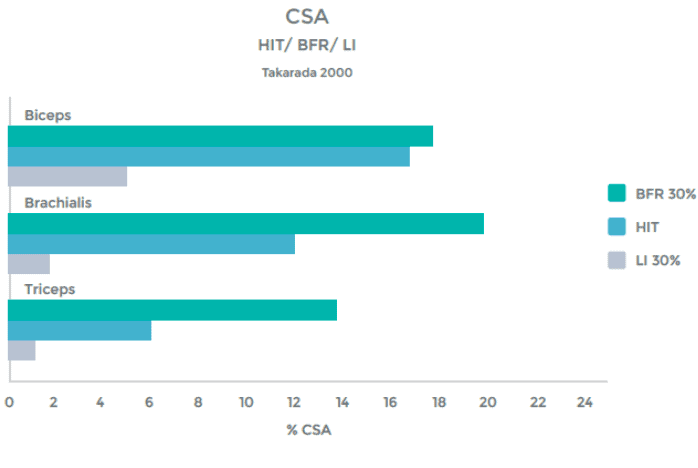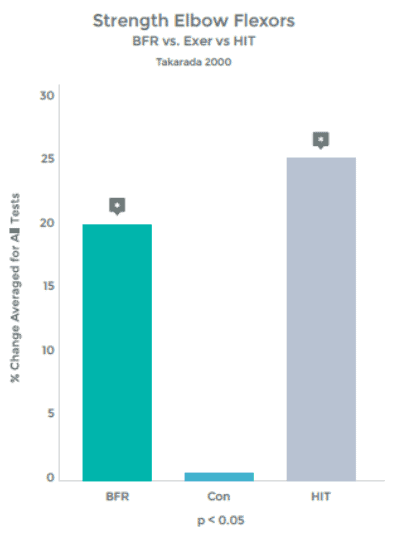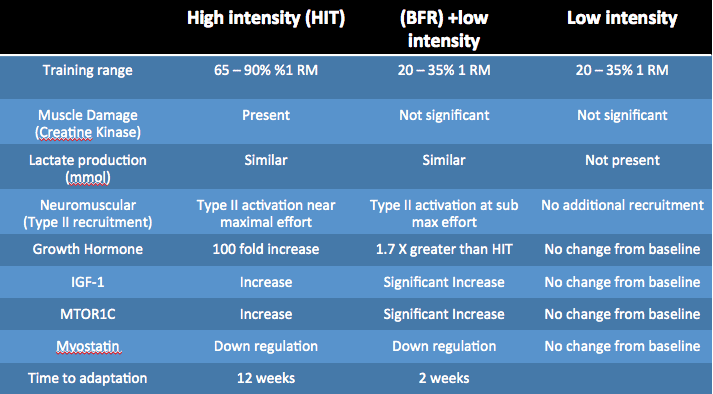Blood flow restriction training has received huge amounts of attention in the strength & conditioning, rehabilitation, and research worlds. Its’ proponents cite huge amounts of research showing it a valuable tool for promoting strength and hypertrophy gains. In the first of this article, series, we will do a general overview of the science behind blood flow restriction training. In part 2, we’ll cover how to practically apply this science for your specific goals.
See my previous article on “The Best BFR Devices.”
The Science of Blood Flow Restriction
The majority of research focuses on looking at strength and hypertrophy gains during BFR training. Research on traditional loading requirements for hypertrophy during weightlifting suggests loads as heavier than 65% of an individual’s one rep max (1rm) must be used to create hypertrophy gains. So a 200lb bench presser must bench at loads greater than 130lbs to create a hypertrophy response.
Research on blood flow restriction training shows that loads as low as 20-30% of 1rm can create the same hypertrophy stimulus!
This is a very significant difference in two specific training goals:
- The athlete recovering from an injury or surgery that isn’t able to load the injured tissue with heavy weights. BFR will allow us to get strength & hypertrophy gains even at light loads. One systematic review wrote, “Compared with low-load training, low-load BFR training is more effective, tolerable and therefore a potential clinical rehabilitation tool.”
- The athlete already doing a lot of heavy lifting that needs extra hypertrophy work but can’t tolerate adding more heavy volume to their program.

Comparison of traditional high-intensity resistance exercise (HIT) to BFR training and low-intensity training (LI)
Other research looking at strength gains has shown significant increases in strength during BFR training. It’s important to note these strneght gains are less than that seen with heavy loading. But, again, during times where we can’t load heavy this is very promising that we can still get stronger!

Comparison of traditional high-intensity resistance exercise (HIT) to BFR training and low-intensity training (LI)
So how does BFR create this hypertrophy and strength stimulus? Let’s first look at a simplified formula for muscle growth:
Amount of Muscle Growth =
Muscle Protein Synthesis – Muscle Protein Breakdown
Simply put, if you add more protein to your muscles than you breakdown, you will build muscle. If you breakdown more than you synthesis, you lose muscle.
MUSCLE PROTEIN BREAKDOWN
In traditional resistance exercise, loading the muscle stretches the sarcomeres leading to cytoskeletal matrix damage. An inflammatory cascade follows to build muscle. There are several different theories on the mechanisms most important for driving hypertrophy that is too detailed for this article. To dive deeper into this topic, see the work of Brad Schoenfeld.
This muscle protein breakdown is why many athletes experience delayed onset muscle soreness (DOMs) after working out. DOMs isn’t necessarily a bad side-effect but can have performance-limiting effects of athletes playing sports if they aren’t recovered for their games.
During BFR, measures of muscle damage such as creatine kinase, lipid peroxides, torque output of muscles, and delayed onset muscle soreness (DOMS) are minimally elevated. Meaning in our muscle growth formula, we don’t have muscle protein breakdown! This is excellent news if you need strength for your sport but can’t afford to lift heavy due to short turn arounds between events. Great examples of this would be with basketball and baseball players that have minimal time off between games. The below video shows Dwight Howard’s utilization of BFR as part of his training.
MUSCLE PROTEIN SYNTHESIS
During blood flow restriction training, limited oxygen to the muscle means that the slow-twitch, Type I muscle fibers aren’t very active as they require oxygen as fuel. Instead, the bigger, faster Type II muscle fibers are recruited. To recruit Type II muscle fibers during traditional resistance exercises, we usually need to perform exercises at a very high intensity. But the oxygen limitations flip that upside down!
Why does that matter? Lactate acid is very important to growth hormone release. Growth hormone secretion levels are 170% higher after BFR than traditional resistance exercises!
Now contrary to popular belief, growth hormone is not involved in protein synthesis or muscle hypertrophy. Instead, it serves a protective role for tendons and muscle collagen structures as it increases collagen synthesis. This has important rehab from injury implications as well as making BFR a great tool for recovery in athletes.
When it comes to the genes and hormones directly related to muscle hypertrophy, BFR has been shown to have significant positive benefits on IGF-1, MTORC1, and myostatin.
Meaning that blood flow restriction training creates a large increase in muscle protein synthesis.
Back to our muscle growth formula….
A large increase in protein synthesis with little muscle damage means we are putting the body in a very good place for building muscle!
Case Example:
As a great case example, elite Olympic weightlifter Jared Fleming tore his ACL at the world championships and did his rehab with me utilizing blood flow restriction training. While lots of research suggests that 65% of patients demonstrate >20% quad weakness compared to contralateral one year after ACL reconstruction (Sachs 1989), Jared’s surgical leg was 1 inch larger than his healthy leg three months after surgery!
https://www.instagram.com/p/BDEIslxBE20/?taken-by=thebarbellphysio
Here is a quick overview of all of the above:







